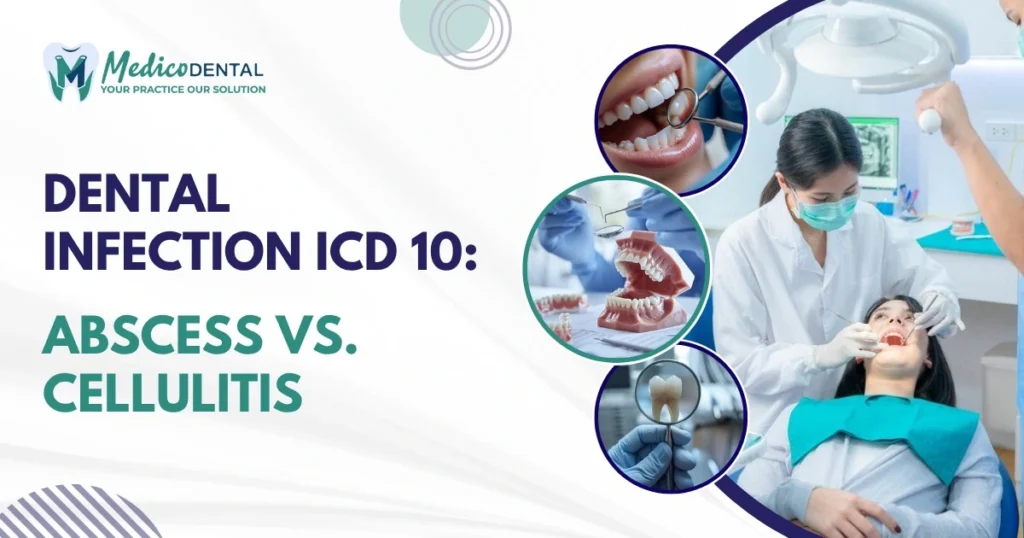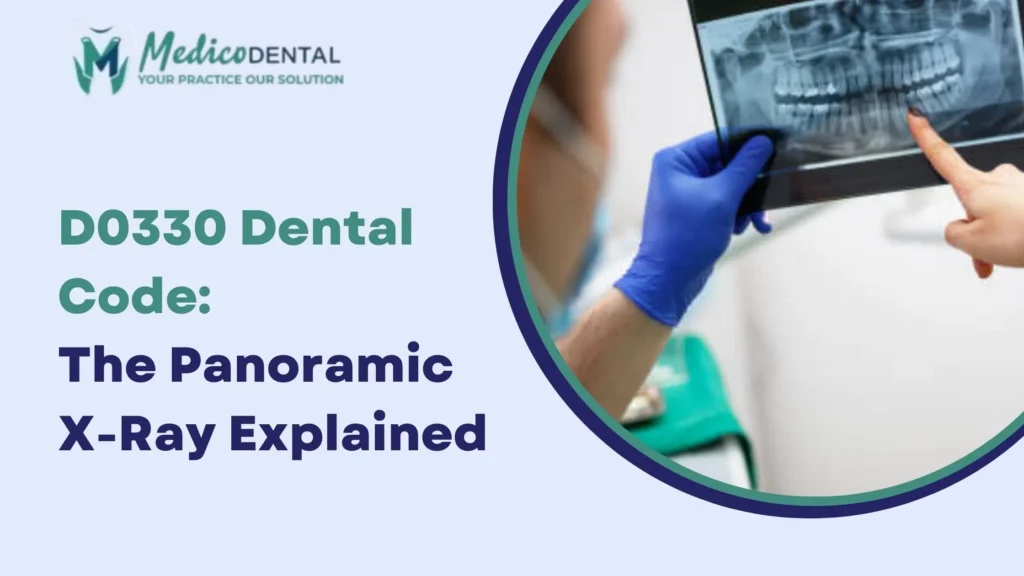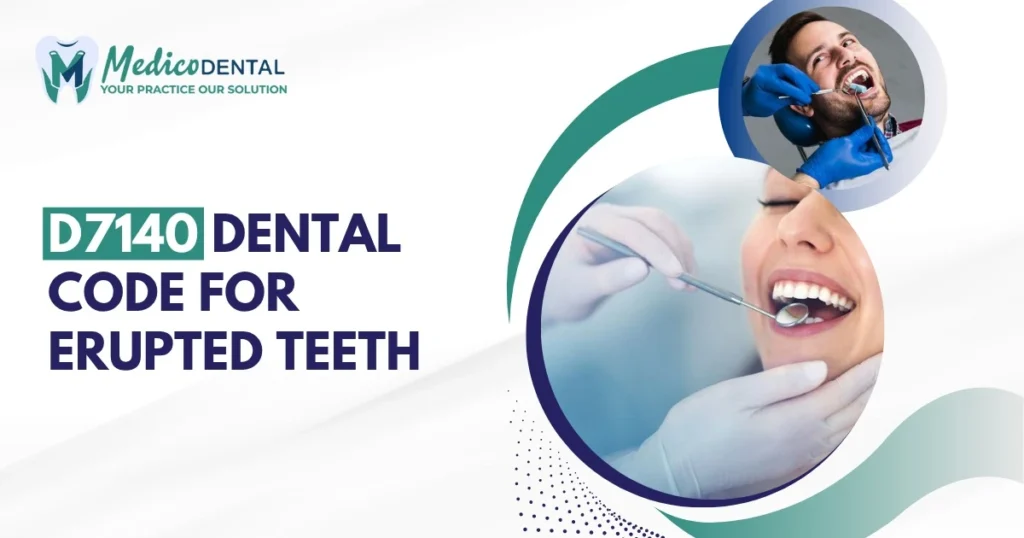Dental infections, ranging from tooth abscesses to severe periodontitis, are among the most common reasons for patients seeking dental care. Correctly diagnosing and documenting these conditions is crucial for effective treatment, insurance claims, and patient care. The ICD-10 (International Classification of Diseases, 10th edition) system provides a standardized method for recording and coding dental infections. This guide will help you understand the importance of using ICD-10 codes for dental infections, ensuring accurate billing and proper treatment management.
Overview of Dental Infections
Dental infections are common yet serious conditions that can significantly impact oral health if left untreated. These infections typically arise from bacteria, which can enter the body through damaged teeth, gums, or oral tissues. The most common dental infections include:
Tooth Abscesses
A tooth abscess is a collection of pus that forms at the root of an infected tooth. This condition is often painful and requires prompt treatment to prevent the infection from spreading to surrounding tissues and bones.
Periodontitis
This is an infection of the gums that, if left untreated, can lead to gum recession, bone loss, and even tooth loss. It typically occurs when plaque and tartar buildup on the teeth lead to an inflammatory response from the body.
Pulpitis
Pulpitis refers to inflammation of the tooth pulp, which is the soft tissue inside the tooth containing blood vessels and nerves. If left untreated, pulpitis can progress to irreversible damage, often requiring a root canal to treat.
These infections are not only painful but can lead to more severe health issues, including systemic infections that can spread to other areas of the body. It’s crucial for dental professionals to identify and address these infections early to avoid complications.
Importance of Using ICD-10 Codes for Dental Infections
Ensures Accurate Diagnosis and Treatment
ICD-10 codes provide a standardized way to document and classify dental infections. Accurate coding ensures that each infection type, whether it’s an abscess, periodontitis, or pulpitis, is properly identified. This is essential for effective treatment, as the type of infection determines the treatment approach. For example, an abscess may require drainage and antibiotics, while pulpitis might require a root canal.
Streamlines Billing and Insurance Reimbursement
In the healthcare system, accurate ICD-10 coding plays a crucial role in medical billing. Insurance companies require specific codes to process claims and reimburse healthcare providers. Without the correct ICD-10 code, a claim could be delayed or rejected, leading to financial losses for the practice. By using the proper codes, dental professionals can ensure that treatments are reimbursed appropriately and avoid issues with insurance claims.
Facilitates Consistency and Communication
ICD-10 codes help ensure consistency in how dental infections are documented and communicated between healthcare providers. For example, if a patient is referred to a specialist or moves to a new dentist, having the infection clearly documented with an accurate ICD-10 code ensures that the new provider understands the diagnosis quickly. This improves patient care by making sure the treatment plan is based on accurate, consistent information.
Supports Public Health and Research
ICD-10 codes are also used in epidemiological tracking to monitor the prevalence of dental infections. This data is important for public health organizations to identify trends, allocate resources, and develop preventive measures. Research studies also rely on accurate coding to gather data and analyze outcomes, helping to improve treatment methodologies and patient care in the long term.
Legal and Compliance Purposes
Using the correct ICD-10 codes ensures compliance with healthcare regulations. It helps meet the legal requirements for accurate reporting, which is essential for avoiding audits, penalties, or legal issues. Dental practices that fail to use proper coding may face regulatory scrutiny or financial consequences.
What is ICD-10 and Why It Matters in Dentistry
Definition of ICD-10
ICD-10 is a comprehensive and standardized coding system used globally to classify and document diseases, injuries, and other health conditions. For dental professionals, it is a vital tool in capturing detailed information about dental infections, conditions, and treatments. The ICD-10 system allows for precise coding, ensuring that each diagnosis is accurately represented for clinical records, treatment plans, and insurance claims.
Role of ICD-10 Codes in Medical Billing and Documentation
In the context of dentistry, ICD 10 codes play a pivotal role in the medical billing process. They allow dentists to classify the diagnosis of dental infections, ensuring that insurance companies are provided with the correct information to reimburse for procedures and treatments. Additionally, these codes help dental practices manage patient records, track health trends, and communicate diagnoses to other healthcare providers.
Accurate ICD-10 coding is essential for reducing the risk of claim denials, speeding up reimbursements, and improving patient outcomes by ensuring that proper treatments are billed and documented.
Common Dental Infections and Their ICD-10 Codes
Overview of Common Dental Infections
Dental infections can range from mild conditions that cause discomfort to severe cases that lead to tooth loss or systemic health issues. Some of the most common dental infections include:
-
Abscesses: A localized collection of pus caused by bacterial infection, often painful and requiring immediate attention.
-
Periodontitis: A severe gum infection that damages the soft tissue and bone supporting the teeth, leading to tooth loss if untreated.
-
Pulpitis: Inflammation of the tooth pulp, which can be reversible or irreversible, often resulting in intense tooth pain.
These infections, if not treated promptly, can lead to serious health complications and even affect a patient’s overall well-being.
List of ICD-10 Codes for Specific Dental Infections
Here are the ICD-10 codes for some common dental infections:
-
K04.7: Periapical abscess without sinus
-
K05.1: Acute periodontitis
-
K04.2: Reversible pulpitis
-
K04.3: Irreversible pulpitis
-
K08.8: Other specified diseases of the teeth and supporting structures
Each of these codes corresponds to a different stage or type of infection, and using the correct code ensures proper treatment and billing.
How to Code Dental Infections in ICD-10
Step-by-Step Guide to Correctly Coding Dental Infections
Diagnose the Condition
The first step in coding dental infections is to accurately diagnose the condition. Whether it’s an abscess, periodontitis, or pulpitis, the diagnosis should be made based on the patient’s symptoms, medical history, and examination.
Select the Correct ICD-10 Code
Once the diagnosis is confirmed, choose the corresponding ICD-10 code. For example, for a tooth abscess, the correct code might be K04.7, while for periodontitis, you would use K05.1. Make sure to use the most specific code possible to accurately reflect the condition.
Document the Diagnosis
Record the diagnosis and selected code in the patient’s medical records, noting any additional symptoms or complications. This helps in monitoring the progression of the infection and ensuring continuity of care.
Verify with Clinical Guidelines
Refer to any clinical guidelines or professional resources to ensure that the chosen ICD-10 code matches the patient’s condition and treatment requirements.
Tips for Accurate Coding and Documentation
-
Always use the most specific code available. If the infection is localized or involves a specific tooth, include that detail in the documentation.
-
Keep updated with any changes or revisions to the ICD-10 system. Regularly reviewing updates ensures that your coding remains accurate and compliant with the latest standards.
If the infection has multiple components (e.g., abscess with periodontitis), you may need to use more than one code to accurately reflect the condition.
Importance of Accurate ICD-10 Coding for Dental Infections
Accurate coding for dental infections is critical not just for clinical purposes, but also for administrative functions such as billing and insurance. By using the correct ICD-10 codes, dental professionals ensure that patients receive appropriate care, insurance claims are processed correctly, and reimbursement is secured without issues. Incorrect coding, on the other hand, can lead to unnecessary complications, including delayed treatments, claim denials, and financial losses.
How Accurate Coding Impacts Patient Care, Billing, and Insurance Claims
-
Patient Care: Accurate ICD 10 coding helps ensure that the correct treatment plan is followed. It helps providers identify the precise condition, which informs the treatment approach, medications, and follow up care.
-
Billing: When dental infections are correctly coded, the billing process becomes smooth, reducing the chances of claim rejections. Accurate coding means that the dental practice is reimbursed appropriately for the services provided.
-
Insurance Claims: Dental insurance companies require specific ICD 10 codes to process claims. Using the wrong code can lead to delayed or denied reimbursements, which could also affect patient satisfaction and practice finances.
Consequences of Incorrect Coding
-
Claim Denials: Incorrect codes can trigger rejections or delays from insurance companies, making it difficult to get paid for services rendered.
-
Legal and Financial Risks: Repeated errors in coding can lead to audits or even legal consequences. Overbilling or underbilling due to incorrect codes can result in penalties.
-
Delayed Treatments: When an infection is incorrectly coded, the patient may not receive the necessary treatment promptly, potentially worsening their condition.
-
Hindrance to Accurate Medical Records: Incorrect coding compromises the accuracy of patient medical records, which can affect future treatment decisions.
ICD 10 Codes for Tooth Abscess and Other Dental Infections
Understanding which ICD 10 codes correspond to specific dental infections is crucial for correct documentation and treatment. Here’s a closer look at the key codes for common dental infections.
Detailed Explanation of ICD 10 Codes for Abscesses, Pulpitis, and Related Conditions
-
K04.7: Periapical Abscess Without Sinus
-
This code is used for a tooth abscess at the tip of the root without an associated sinus opening. It is typically diagnosed when there is localized pain, swelling, and a collection of pus in the surrounding tissues.
-
-
K04.2: Reversible Pulpitis
-
This refers to an inflammation of the tooth pulp (the innermost part of the tooth). Reversible pulpitis is a condition where the pulp is irritated but can return to normal with proper treatment.
-
-
K04.3: Irreversible Pulpitis
-
Irreversible pulpitis occurs when the inflammation in the pulp is so severe that it causes permanent damage. It often results in severe pain and may require a root canal or extraction.
-
-
K05.1: Acute Periodontitis
-
Acute periodontitis is a rapid infection of the gum tissues that can cause bleeding, swelling, and pain. The condition may be due to bacterial infection or trauma to the gums.
-
When to Use Specific Codes
-
Use K04.7 when diagnosing a periapical abscess without sinus involvement. This code is most appropriate when there is no visible drainage point, and the infection is confined to the root area.
-
K04.2 or K04.3 should be used depending on the severity of the pulpitis. Use K04.2 for reversible pulpitis, where the pulp inflammation can still be reversed, and K04.3 for irreversible pulpitis, indicating permanent damage.
-
K05.1 is used when the patient presents with symptoms of acute periodontitis, such as swollen gums, pain, and bleeding, often accompanied by infection around the tooth root.
Treatment and Management of Dental Infections
Effective treatment of dental infections often requires a combination of antibiotics, dental procedures, and ongoing monitoring to ensure the infection resolves completely. Below are the common treatments used for dental infections:
Common Treatments for Dental Infections
-
Antibiotics: Prescribed to control bacterial infections, especially when an abscess is present. Antibiotics can help manage the infection before further procedures like drainage or surgery are performed.
-
Root Canal Treatment: If the infection has reached the tooth pulp, a root canal is performed to remove the infected tissue and seal the tooth.
-
Extraction: In cases where the infection is severe and the tooth cannot be saved, an extraction may be necessary to prevent the infection from spreading to other areas.
-
Scaling and Root Planing: For gum infections like periodontitis, scaling and root planing remove plaque and tartar build up from beneath the gumline, helping to prevent the spread of infection.
How Coding Affects Treatment Plans and Documentation
ICD 10 codes help dentists select the right treatment approach. For example, knowing whether a patient has an abscess or pulpitis will influence whether antibiotics, a root canal, or an extraction is required. Proper coding ensures that all the necessary treatments are documented, aiding in both clinical care and insurance documentation.
Conclusion
Accurate ICD 10 coding for dental infections is not only essential for correct treatment and management but also for proper billing and reimbursement. Whether dealing with abscesses, pulpitis, or periodontal infections, using the correct codes ensures that patients receive the appropriate care and that dental practices are reimbursed correctly. Regular training and staying updated with ICD 10 changes are crucial to maintaining accuracy in documentation and billing, which ultimately leads to better patient outcomes and a smoother operational process for dental practices.
FAQs
What ICD-10 code should I use for a tooth abscess?
Ans. For a tooth abscess, use K04.7, which is the code for periapical abscess without sinus. This code is appropriate when the infection is confined to the tip of the root and no sinus tract is present.
How can incorrect coding impact my dental practice?
Ans. Incorrect coding can lead to claim denials, delayed reimbursements, or even legal consequences. It can also result in unnecessary treatments being performed or vital treatments being overlooked, negatively impacting patient care.
Do I need to use multiple ICD-10 codes for complex dental infections?
Ans. Yes, if a patient presents with multiple dental conditions, such as both an abscess and periodontitis, you may need to use multiple ICD-10 codes to document all aspects of the infection.
Can ICD-10 codes help prevent complications in treatment?
Ans. Yes, by using the correct codes, dental professionals can ensure that the most appropriate treatments are prescribed, preventing complications and improving the chances of successful outcomes.



